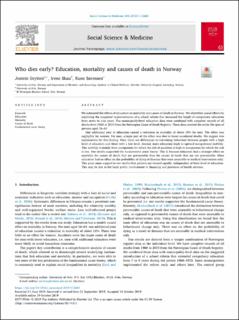Who dies early? Education, mortality and causes of death in Norway
Journal article, Peer reviewed
Published version
Permanent lenke
https://hdl.handle.net/11250/2733318Utgivelsesdato
2019Metadata
Vis full innførselSamlinger
- Scientific articles [2181]
Sammendrag
We estimated the effects of education on mortality and causes of death in Norway. We identified causal effects by exploiting the staggered implementation of a school reform that increased the length of compulsory education from seven to nine years. The municipality-level education data were combined with complete records of all deaths from 1960 to 2015 from the Norwegian Cause of Death Registry. These data covered the entire life span of persons aged 16–64. One additional year of education caused a reduction in mortality of about 10% for men. The effect was negligible for women. For men, a large part of the effect was due to fewer accidental deaths. We suggest two explanations for this finding. First, there are differences in risk-taking behaviour between people with a high level of education and those with a low level. Second, more education leads to upward occupational mobility. This mobility is mainly from occupations for which the risk of accidents is high to occupations for which the risk is low. Our results supported the fundamental cause theory. This is because education had a stronger effect on mortality for causes of death that are preventable than for causes of death that are not preventable. More education had no effect on the probability of dying of diseases that were amenable to medical intervention only. This gives some support to our results that patients are treated equally, independent of their level of education. This may be due to the large public involvement in financing and provision of health services.

